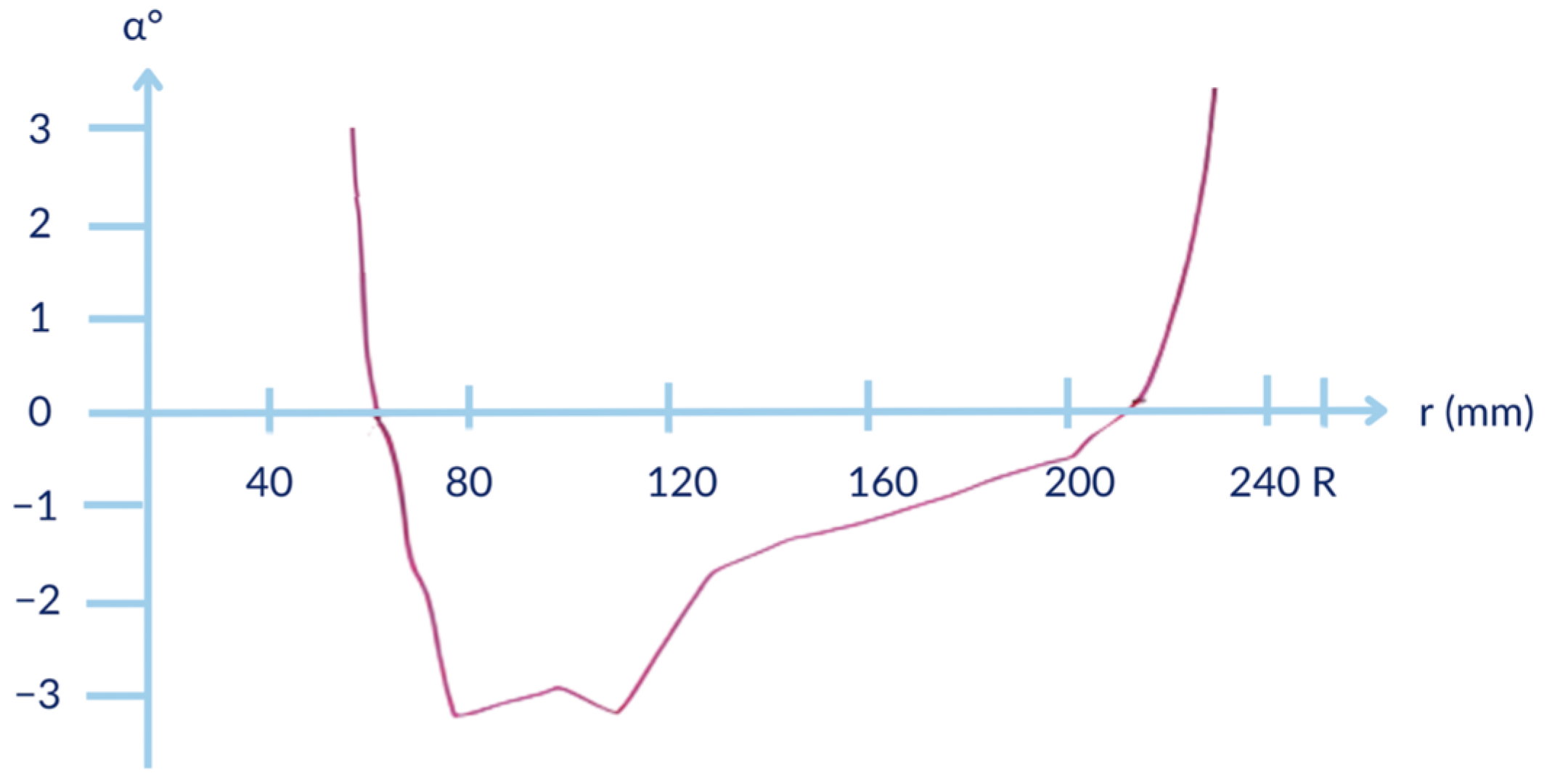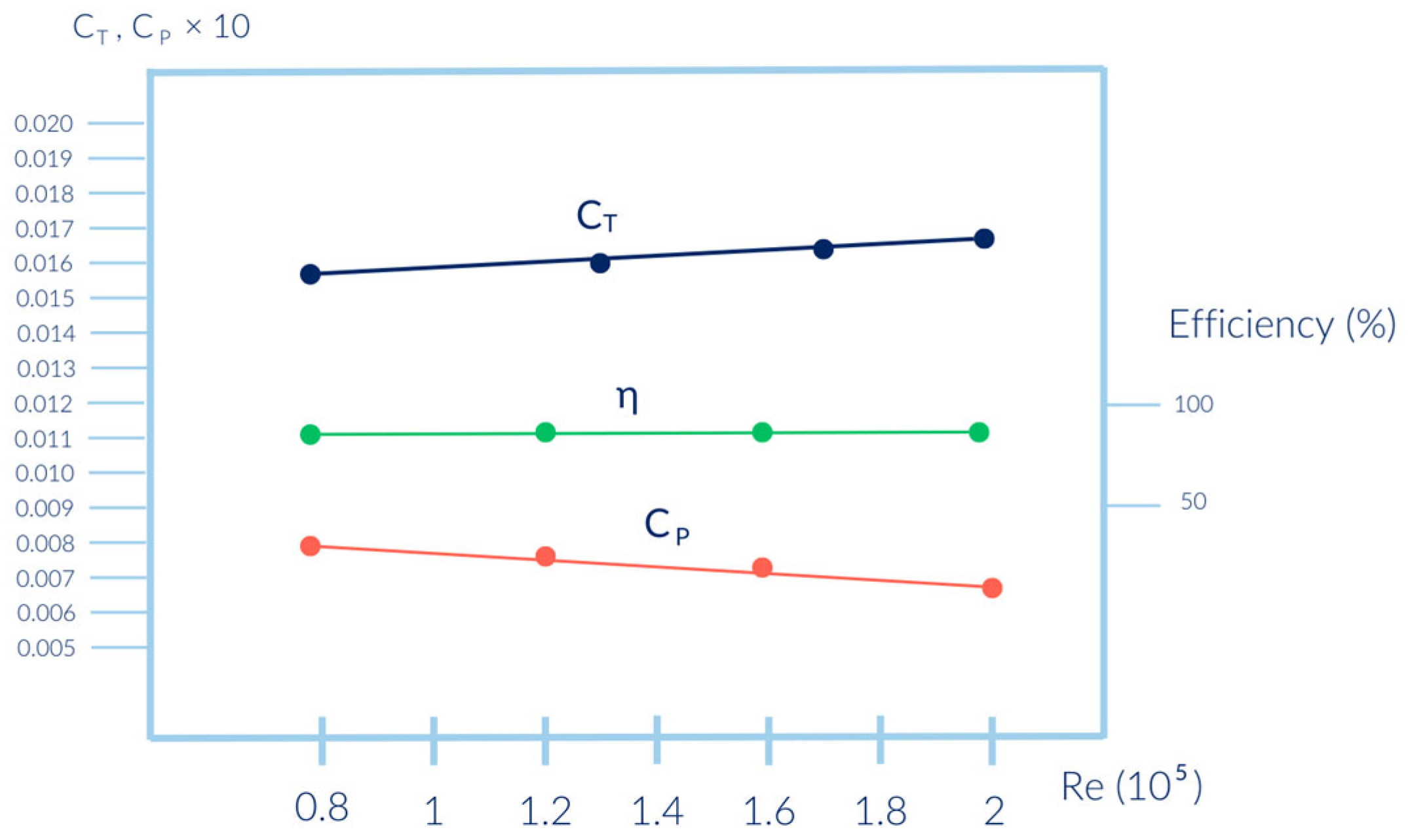The Efficiency of Drone Propellers—A Relevant Step Towards Sustainability †
Abstract
1. Introduction
2. Approach Methods
3. Test Object
4. Results
5. Discussion
6. Conclusions
- The best static efficiency of a commercial static use-oriented propeller reaches approximately 83% when the geometric pitch is about 1/3 of the propeller diameter.
- The static efficiency at the constant Re number depends strongly on the geometric pitch, and it may drop more than twice with the geometric pitch increasing from D/3 to D.
- The static efficiency for all tested values of the geometric pitch does not depend considerably on the Reynolds number in the range of 80,000 to 200,000, in spite of clearly detected changes in thrust and power coefficients in that region.
- The most effective blade sections (around 0.75R) in the case of the most efficient blade settings (geometric pitch 0.33D) work at much lower values of angle of attack than the angle of attack for the best lift/drag ratio for the airfoil of those sections.
Author Contributions
Funding
Institutional Review Board Statement
Informed Consent Statement
Data Availability Statement
Conflicts of Interest
References
- Bass, R.M. Small Scale Wind Tunnel Testing of Model Propellers. In Proceedings of the 24th Aerospace Sciences Meeting, Reno, NV, USA, 6–9 January 1986. [Google Scholar]
- Moffitt, B.A.; Bradley, T.H.; Parekh, D.E.; Mavris, D. Validation of Vortex Propeller Theory for UAV Design with Uncertainty Analysis. In Proceedings of the 46th AIAA Aerospace Sciences Meeting and Exhibit, Reno, NV, USA, 7–10 January 2008. [Google Scholar]
- Brandt, J.B. Small-Scale Propeller Performance at Low Speeds. Master Thesis, University of Illinois at Urbana Champaign, Urbana, IL, USA, 2005. [Google Scholar]
- Merchant, M.P.; Miller, L.S. Propeller Performance Measurement for Low Reynolds Number UAV Applications. In Proceedings of the 44th AIAA Aerospace Sciences Meeting and Exhibit, Reno, NV, USA, 9–12 January 2006. [Google Scholar]
- Susi, J.; Unt, K.-E.; Heering, S. Determining the Efficiency of Small-Scale Propellers via Slipstream Monitoring. Drones 2023, 7, 381. [Google Scholar] [CrossRef]
- Deters, R.W.; Ananda, G.K.; Selig, M.S. Reynolds Number Effects on the Performance of Small-Scale Propellers. In Proceedings of the 32nd AIAA Applied Aerodynamics Conference, Atlanta, GA, USA, 16–20 June 2014. [Google Scholar]





Disclaimer/Publisher’s Note: The statements, opinions and data contained in all publications are solely those of the individual author(s) and contributor(s) and not of MDPI and/or the editor(s). MDPI and/or the editor(s) disclaim responsibility for any injury to people or property resulting from any ideas, methods, instructions or products referred to in the content. |
© 2025 by the authors. Licensee MDPI, Basel, Switzerland. This article is an open access article distributed under the terms and conditions of the Creative Commons Attribution (CC BY) license (https://creativecommons.org/licenses/by/4.0/).
Share and Cite
Susi, J.; Unt, K.-E.; Heering, S. The Efficiency of Drone Propellers—A Relevant Step Towards Sustainability. Eng. Proc. 2025, 90, 89. https://doi.org/10.3390/engproc2025090089
Susi J, Unt K-E, Heering S. The Efficiency of Drone Propellers—A Relevant Step Towards Sustainability. Engineering Proceedings. 2025; 90(1):89. https://doi.org/10.3390/engproc2025090089
Chicago/Turabian StyleSusi, Jaan, Karl-Eerik Unt, and Siim Heering. 2025. "The Efficiency of Drone Propellers—A Relevant Step Towards Sustainability" Engineering Proceedings 90, no. 1: 89. https://doi.org/10.3390/engproc2025090089
APA StyleSusi, J., Unt, K.-E., & Heering, S. (2025). The Efficiency of Drone Propellers—A Relevant Step Towards Sustainability. Engineering Proceedings, 90(1), 89. https://doi.org/10.3390/engproc2025090089





